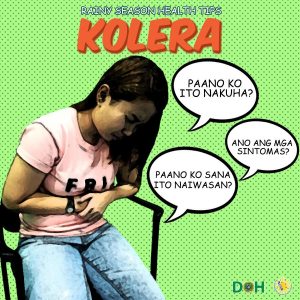With the flooding from Typhoon Gorio over the weekend, the Philippines Department of Health (DOH) issued a waterborne diseases advisory for the following–typhoid fever, cholera, leptospirosis, and hepatitis A.
Typhoid fever is an infectious disease which is also known as enteric fever or just typhoid. It is caused by bacteria known as Salmonella typhi. It spreads through contaminated food and water or through close contact with someone who is infected. Signs and symptoms include high- and low-grade fever for several days, headache, weakness, loss of appetite, either diarrhea or constipation, and abdominal discomfort.

Cholera is an intestinal infection caused by ingestion of food or water contaminated with the bacterium Vibrio cholerae. Its incubation period ranges from less than 1 day to 5 days. The infection causes a profuse, painless, watery diarrhea that can quickly lead to severe dehydration and death if treatment is not promptly given. In extreme cases, cholera is a rapidly deadly disease. A healthy individual may die within 2-3 hours if no treatment is provided.
LISTEN: Cholera: The disease, the Yemen crisis and the vaccine
Leptospirosis is a bacterial infection transmitted by rats through urine and feces. It can contaminate the soil, water, and vegetation. It is caused by Leptospira spirochetes bacteria. Its mode of transmission includes ingesting contaminated food or water, or when broken skin or open wounds are exposed to floodwaters. Its incubation period is 7-10 days.
Hepatitis A, one of the oldest diseases known to humankind, is an infectious disease and caused by Hepatitis A virus (HAV). The most common mode of transmission is ingestion of food contaminated with human waste and urine of persons who have Hepatitis A. Its symptoms usually include fever, flu-like symptoms such as weakness, muscle and joint aches, loss of appetite and dizziness. Other symptoms may be so mild that they go unnoticed.



2 thoughts on “Philippines: Typhoons prompt advisory over typhoid, cholera, leptospirosis and hepatitis A”